Sambar Rice, or Sambar Sadam in Tamil, is a comforting South Indian dish loved for its rich flavors. It combines rice with a spiced lentil-vegetable stew. Not only nutritious, but also versatile—add veggies as you please! A true staple in every South Indian kitchen!
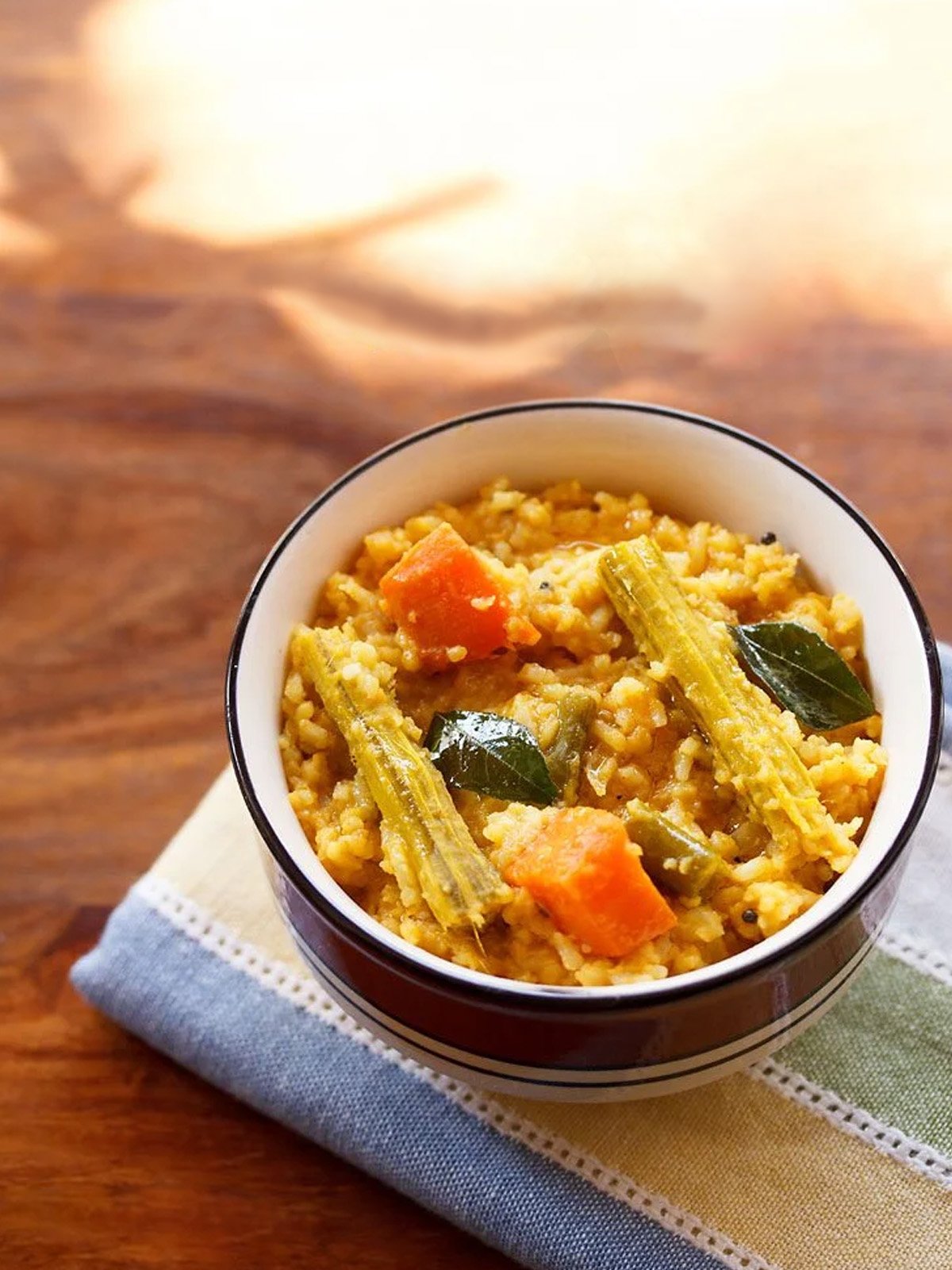
Jump to:
About Sambar Rice
Sambar was first created during the Chola Dynasty (around the 11th century) as a simple dish with lentils and tamarind.
Over time, it evolved into the rich, tangy stew we enjoy today, packed with spices. This transformation made it a beloved dish, especially when served with rice.
Sambar Rice varies across South India. In Tamil Nadu, it’s known for its hearty, spicy flavor, often topped with ghee.
In Karnataka, jaggery or coconut adds a sweet touch, while in Kerala, it's paired with papadam or avial. Meanwhile, Andhra Pradesh serves a spicier version with red chili and ginger.
In conclusion, whether you like it mild or fiery, sambar rice is a dish that keeps evolving, but always stays true to its roots.
It’s versatile, and the flavors just keep getting better with every region’s unique twist!
What is Sambar Rice?
Sambar Rice, a popular dish in South Indian homes, combines the tangy and spicy sambar with soft, fluffy rice.
It’s often enjoyed as a one-pot meal, making it perfect for lunch or dinner 🍽️. The blend of spices and lentils creates a hearty and satisfying dish that everyone loves.
Not only is Sambar Rice delicious, but it also carries a sense of nostalgia. For many, it reminds them of family gatherings, festivals, and temple prasadams (offerings). The comforting aroma and flavors bring back fond memories of special moments with loved ones.
Whether served on a regular day or during celebrations, Sambar Rice holds a special place in the hearts of many. It’s a dish that’s simple yet full of meaning, bringing people together, time and again.
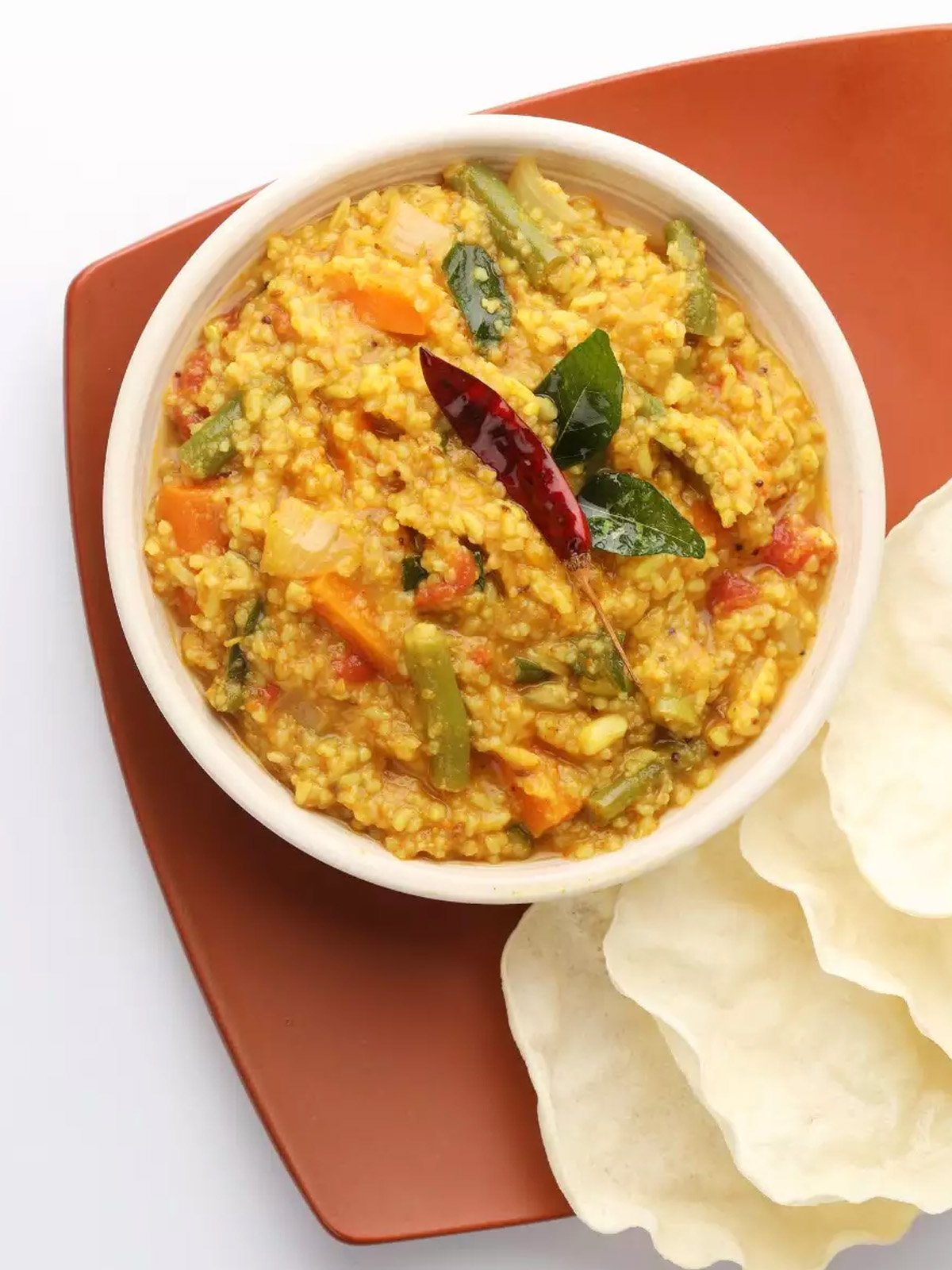
Cooking Techniques: Traditional vs. Modern
- Traditional Methods
- Traditionally, cooking was done in clay pots. These pots slow-cook the food, giving it a rich, unique flavor. The downside? It takes more time, but the results are worth it!
- Modern Methods
- Nowadays, we use things like pressure cookers or Instant Pots. These gadgets cook food super fast, saving time and energy. Plus, they lock in the flavors really well !
Craving more mouthwatering recipes?
- Sambar Magic: A bowl of warmth and spice, ready to elevate any meal!
- Veg Biryani Bliss: Fragrant rice, mixed veggies, and spices – it's a fiesta on your plate!
- Palak Rice Delight : A healthy, green twist to your regular rice that’s packed with flavor!
- Rajma Rice Love: Comfort food at its best, with soft beans and perfectly cooked rice!
- Tomato Rice Temptation : A tangy, savory treat that will leave you coming back for more!
What You'll Need to Make This Sambar Rice?
Key Ingredients:
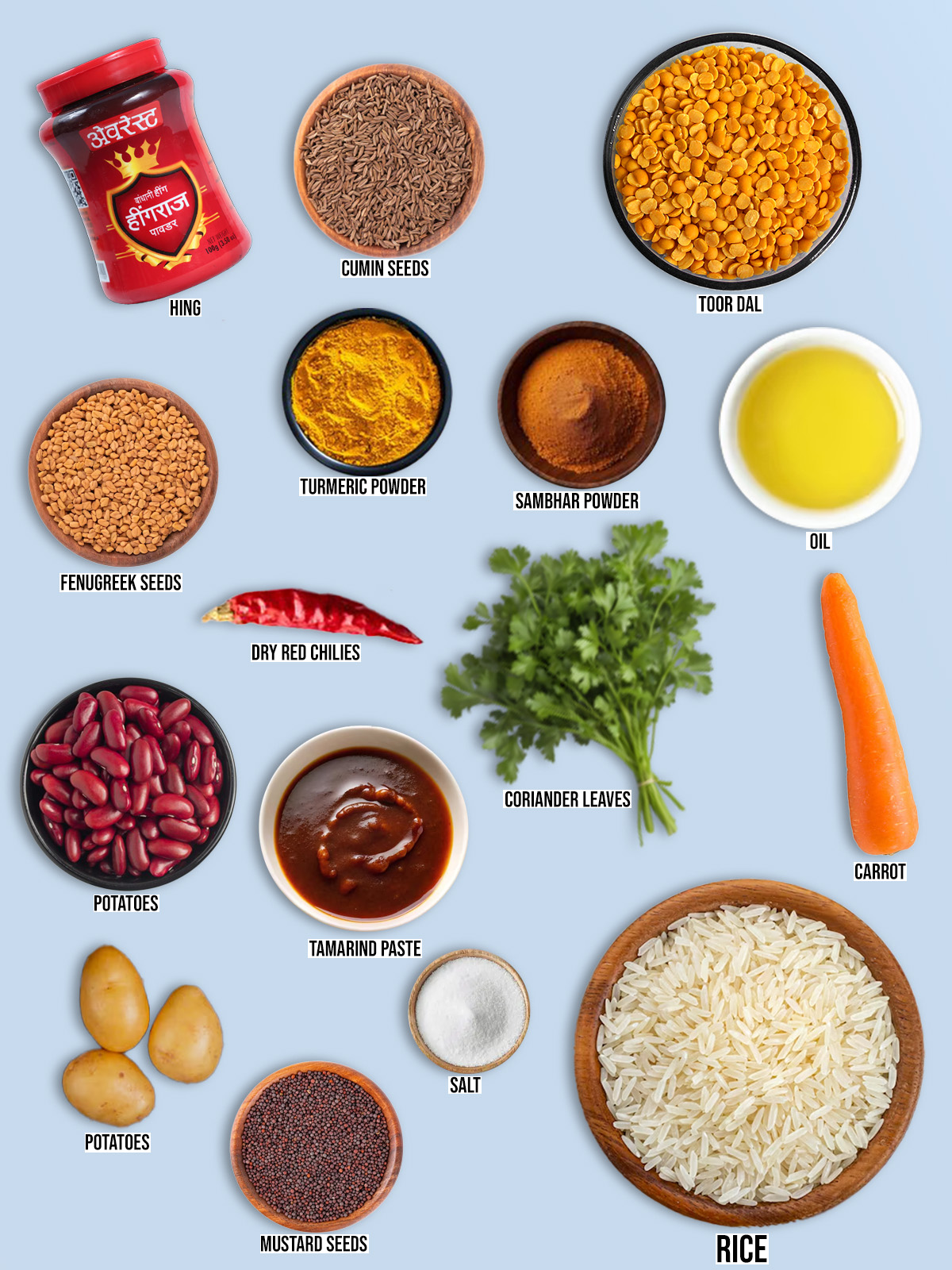
Ingredients Notes:
- Rice: First thing to remember, rice is the base of the dish. Not only does it provide the perfect texture, but it also soaks up the tangy and spicy sambar sauce, making it a complete meal.
- Sambar Powder: Secondly, the key to sambar rice’s bold flavor lies in the sambar powder. This spice mix is packed with aromatic ingredients like coriander, cumin, and mustard seeds, giving it that unique, zesty taste. It’s the heart of the dish!
- Tamarind: Then again, tamarind adds the tangy twist. It balances the spiciness, creating a perfect fusion of flavors. Traditionally, tamarind was used for its sourness during the Chola dynasty, and it still remains essential to the dish.
- Lentils (Toor Dal): To add richness and protein, lentils, particularly toor dal, are used. These provide a creamy texture once cooked, making the dish both nutritious and filling.
- Vegetables: You can add a variety of vegetables, such as carrots, beans, and eggplant. Not only do they contribute color and texture, but they also absorb the flavors of the sambar, making every bite interesting.
- Ghee (Clarified Butter): Finally, a dollop of ghee on top elevates the flavor. It’s a finishing touch that’s commonly used in South Indian dishes. Ghee gives it a rich, buttery flavor and helps balance the heat from the spices.
How to Make Sambar Rice
Step by Step Instructions
1. Cooking Rice
- Firstly, begin by choosing the right rice! You can use regular white rice, basmati, or any rice you like.
- Secondly, wash the rice thoroughly to remove excess starch, which will keep it from getting too sticky.
- Thirdly, cook the rice using a pressure cooker or rice cooker. If you're using a pressure cooker, add the rice and water in a 1:2 ratio. For a rice cooker, follow the instructions for your specific model.
- Lastly, ensure that the rice is fluffy, not mushy. No sooner than it’s cooked, fluff it with a fork to keep the grains separate.
2. Making the Sambar
A. Tadka (Tempering the Spices)
- Firstly, heat oil in a pan and add mustard seeds, cumin, curry leaves, and dried red chilies to the hot oil. Listen for that satisfying crackle!
- Afterwards, cook them for a few seconds until they release their wonderful fragrance.
B. Cooking Toor Dal
- Meanwhile, cook the toor dal (yellow lentils) in a pressure cooker until soft and creamy. As a result, the dal will become thick and smooth.
- Additionally, you can add some water to get the perfect creamy consistency.
C. Adding Vegetables
- Next, add your veggies like carrots, potatoes, and tomatoes to the cooked dal. As an illustration, potatoes give it a great texture, while tomatoes add flavor!
- After that, let the vegetables cook until they’re tender.
D. Tamarind Magic
- Now, for the tamarind pulp! Add some tamarind to the dal and veggie mix. This will give your sambar that perfect balance of tangy and rich flavor.
- As a matter of fact, tamarind is key to making the sambar deliciously bold and flavorful.
E. Simmering the Sambar
- Subsequently, let everything simmer for a few minutes to allow the spices and flavors to meld together. At this point, the aroma will fill your kitchen, and you’ll be so ready for the next step!
3. Combining Sambar with Rice
- Afterward, check the consistency of your sambar. If it’s too thick, add a little water to thin it out. But if it’s too watery, let it simmer a little longer. You want it to coat the rice perfectly—not too runny, but also not too thick.
- Now that both the rice and sambar are ready, carefully mix them together. You can combine them in a big bowl or directly on your plate.
- Finally, mix well and enjoy!
Flavor Variations: Customizing Your Sambar Rice
Imagine you're cooking with friends, and everyone likes different flavors. Here’s how to make it perfect for all!
Spicy vs. Mild
If your friend loves spice, add more green chilies or red chili powder. But, if someone prefers it mild, use gentle sambar powder for a softer taste.
Add-ins for Extra Flavor
- Coconut: Makes it creamy and smooth.
- Jaggery: Adds a touch of sweetness to balance the tang.
- Curry Leaves : Fresh leaves give a fragrant finish.
Veggie Twists
Try adding mushrooms, zucchini, or pumpkin for a fun twist. Or, go for a colorful mix of veggies for more flavor and nutrients!
Protein Power
Pair it with chicken or fish curry if you want extra protein.
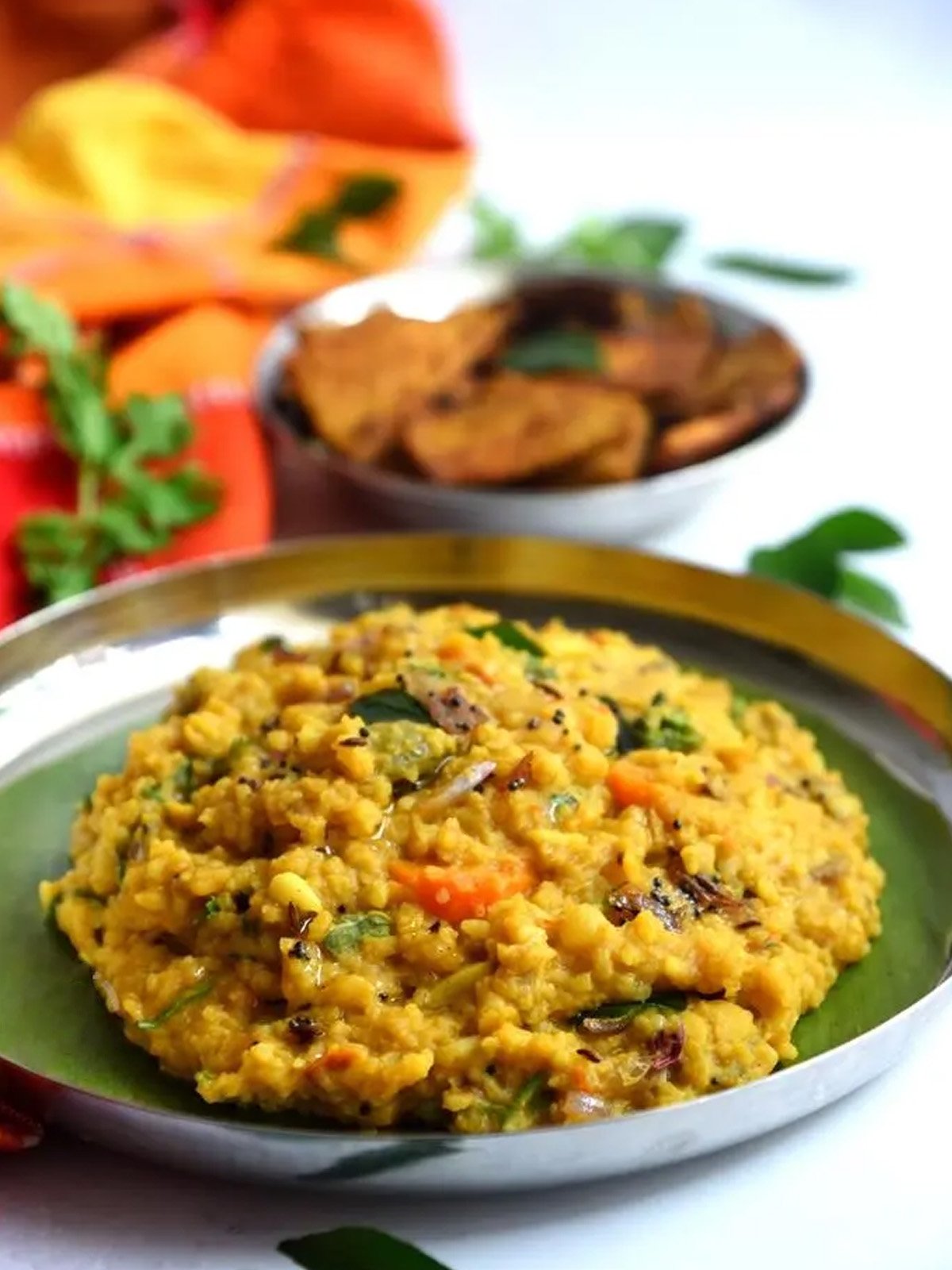
Health Benefits & Nutritional Value of Sambar Rice
- Protein-Power: Toor dal gives this dish a protein boost, making it super filling and nutritious.
- Antioxidants Galore: Spices like turmeric, cumin, and coriander add more than flavor—they're packed with antioxidants that help with digestion and reduce inflammation.
- Fiber Boost: The veggies in sambar, especially drumsticks, are full of fiber, which is awesome for your gut health and digestion.
- Vegan & Gluten-Free: Sambar rice is naturally vegan and gluten-free, perfect for everyone's dietary needs.
Tips & Tricks for Perfect Sambar Rice
1. Perfecting the Tadka: Firstly, make sure to temper your spices at the right temperature—too hot and they’ll burn! On the other hand, when you add fresh curry leaves at the right moment, they give your sambar a delicious aroma. In this case, timing is key!
2. Avoiding Overcooked Rice: As a matter of fact, nobody likes mushy rice! To avoid overcooking, add the rice to the sambar carefully and only cook until the grains are fluffy. That way, they’ll stay nice and separate.
3. Getting the Right Consistency: For instance, if your sambar is too thick, just add some water or veggie stock. Conversely, if it’s too runny, simmer it a bit longer to thicken up. So, you can adjust it to be just right!
4. Storing Leftovers: Afterward, if you have leftover sambar rice, store the sambar and rice separately to keep them fresh. That way, when you reheat, the flavors stay amazing! Without a doubt, this trick will save you from soggy rice and tasteless sambar.
Did you try this Sambar Rice recipe? Leave a ⭐️⭐️⭐️⭐️⭐️ rating below and share it on Instagram, Facebook, and Pinterest!
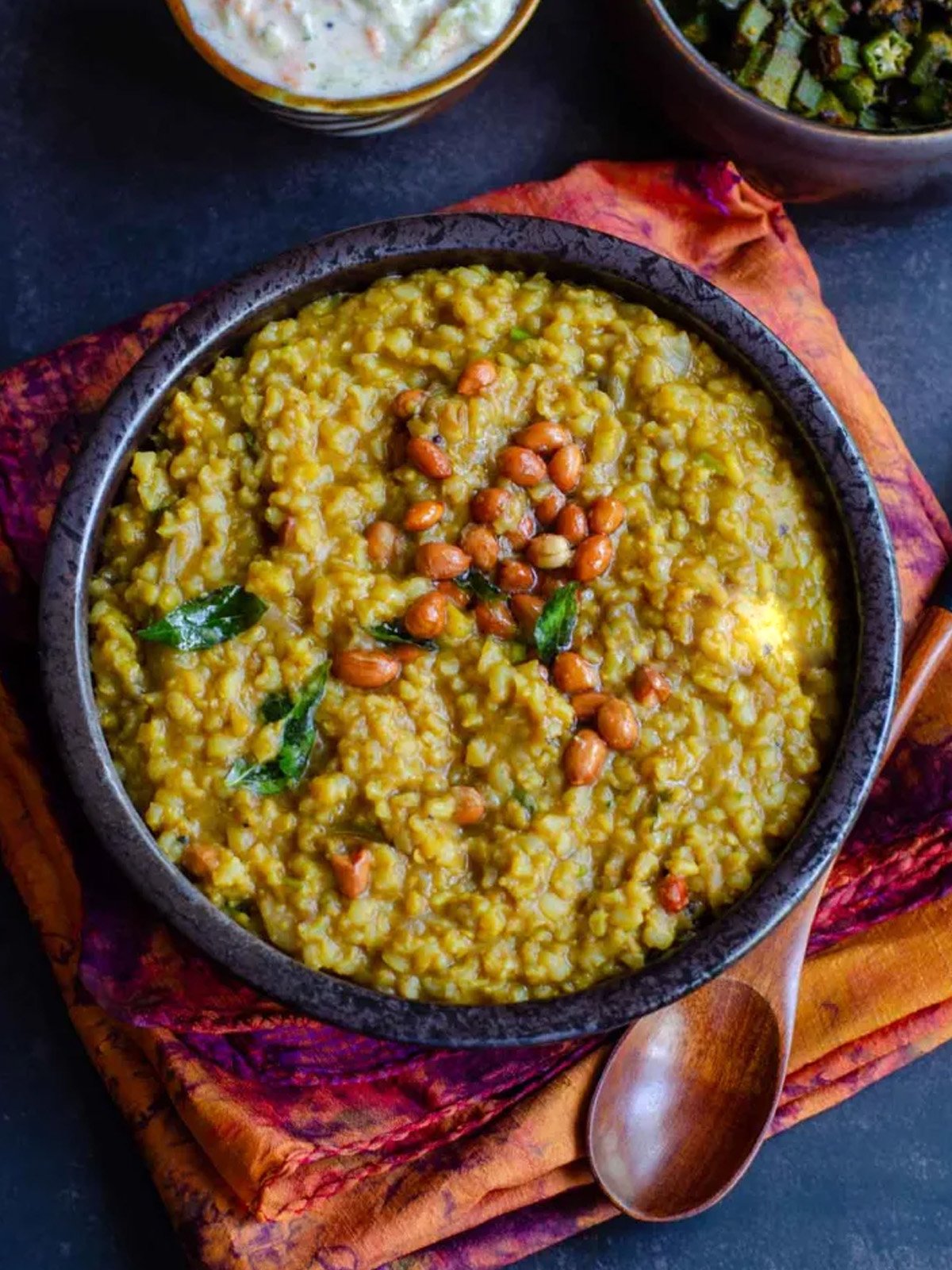
❔FAQs
Yes, you can make Sambhar Rice in a pressure cooker for a quicker preparation. Simply cook the rice, dal, and vegetables together with sambhar spices in the pressure cooker.
Sambhar Rice pairs well with crispy papadam, cucumber raita, coconut chutney, or a side of sautéed greens. It can also be served with a vegetable curry for a more substantial meal.
To adjust the spice level, modify the amount of sambhar powder and red chilies according to your taste. You can start with a smaller quantity and gradually add more if needed.
Yes, Sambhar Rice can be made ahead of time and stored in the refrigerator for up to 2-3 days. Reheat thoroughly before serving. For best results, add a splash of water while reheating if it has thickened.
Sambhar Rice is a nutritious meal that provides protein from lentils, fiber from vegetables, and carbohydrates from rice. It is also a good source of vitamins and minerals, depending on the vegetables used.
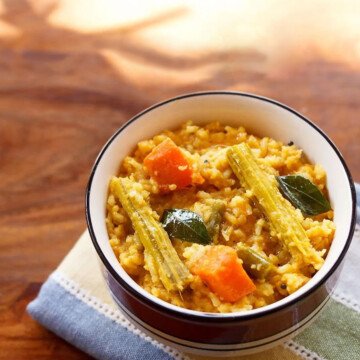
Sambar Rice
Ingredients
For Sambar:
- 1 Cup Toor dal (pigeon peas)
- 2 Cup Mixed vegetables (carrot,beans, potato, pumpkin, etc.) chopped
- 2 tablespoon Tamarind paste
- 2 tablespoon Sambhar powder (store-bought or homemade)
- 1 teaspoon Mustard seeds
- 1 teaspoon Cumin seeds
- 2 Dry red chilies
- ½ teaspoon Fenugreek seeds
- ½ teaspoon Turmeric powder
- ¼ teaspoon Asafoetida (hing)
- 2 tablespoon Oil
- Salt to taste
- Fresh coriander leaves a handful, chopped
For Rice:
- 1 Cup Rice
- 2 Cup Water
Instructions
Cooking Rice
- Firstly, begin by choosing the right rice! You can use regular white rice, basmati, or any rice you like.
- Secondly, wash the rice thoroughly to remove excess starch, which will keep it from getting too sticky.
- Thirdly, cook the rice using a pressure cooker or rice cooker. If you're using a pressure cooker, add the rice and water in a 1:2 ratio. For a rice cooker, follow the instructions for your specific model.
- Lastly, ensure that the rice is fluffy, not mushy. No sooner than it’s cooked, fluff it with a fork to keep the grains separate.
Making the Sambar
A. Tadka (Tempering the Spices)
- Firstly, heat oil in a pan and add mustard seeds, cumin, curry leaves, and dried red chilies to the hot oil. Listen for that satisfying crackle!
- Afterwards, cook them for a few seconds until they release their wonderful fragrance.
Cooking Toor Dal
- Meanwhile, cook the toor dal (yellow lentils) in a pressure cooker until soft and creamy. As a result, the dal will become thick and smooth.
- Additionally, you can add some water to get the perfect creamy consistency.
Adding Vegetables
- Next, add your veggies like carrots, potatoes, and tomatoes to the cooked dal. As an illustration, potatoes give it a great texture, while tomatoes add flavor!
- After that, let the vegetables cook until they’re tender.
Tamarind Magic
- Now, for the tamarind pulp! Add some tamarind to the dal and veggie mix. This will give your sambar that perfect balance of tangy and rich flavor.
- As a matter of fact, tamarind is key to making the sambar deliciously bold and flavorful.
Simmering the Sambar
- Subsequently, let everything simmer for a few minutes to allow the spices and flavors to meld together. At this point, the aroma will fill your kitchen, and you’ll be so ready for the next step!
Combining Sambar with Rice
- Afterward, check the consistency of your sambar. If it’s too thick, add a little water to thin it out. But if it’s too watery, let it simmer a little longer. You want it to coat the rice perfectly—not too runny, but also not too thick.
- Now that both the rice and sambar are ready, carefully mix them together. You can combine them in a big bowl or directly on your plate. 🍽️
- Finally, mix well and enjoy!
Notes
Flavor Variations: Customizing Your Sambar Rice
Imagine you're cooking with friends, and everyone likes different flavors. Here’s how to make it perfect for all!Spicy vs. Mild
If your friend loves spice, add more green chilies or red chili powder. But, if someone prefers it mild, use gentle sambar powder for a softer taste.Add-ins for Extra Flavor
-
- Coconut: Makes it creamy and smooth.
-
- Jaggery: Adds a touch of sweetness to balance the tang.
-
- Curry Leaves: Fresh leaves give a fragrant finish.




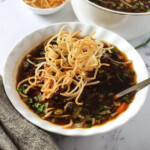





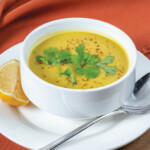

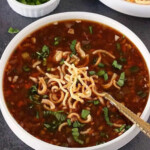
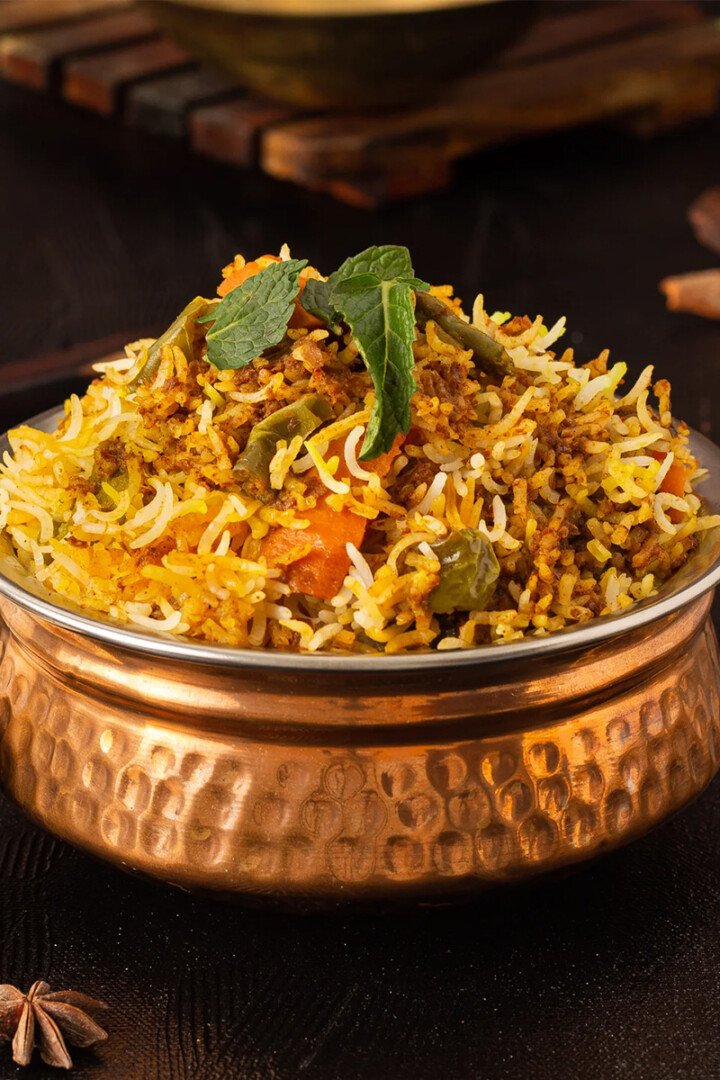
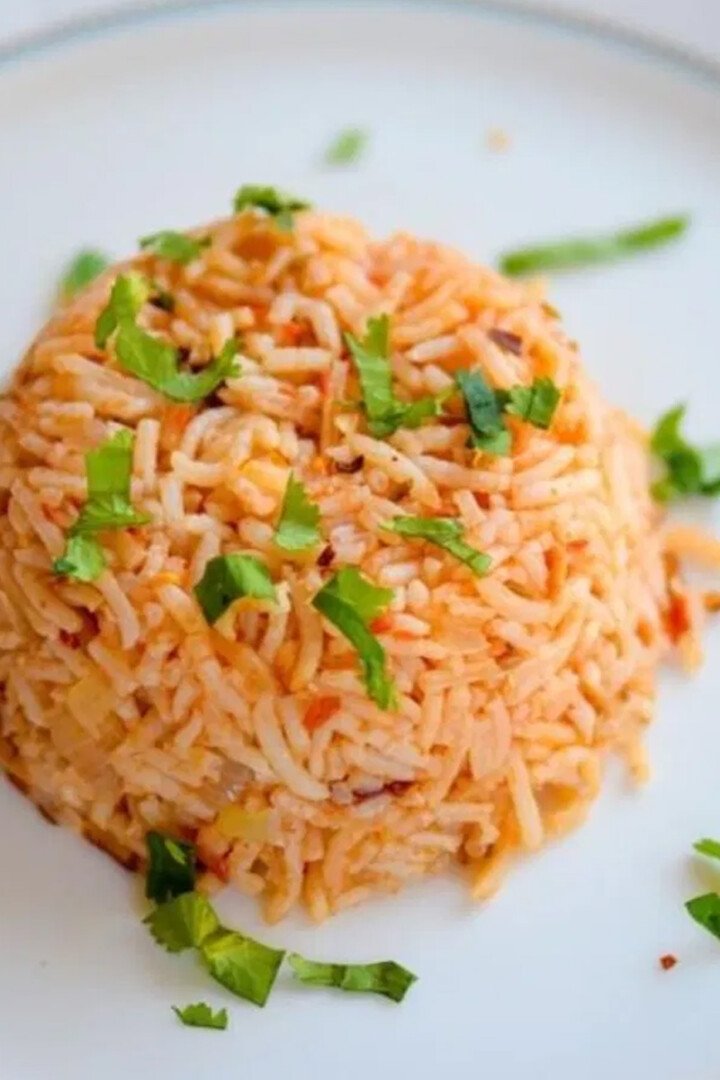
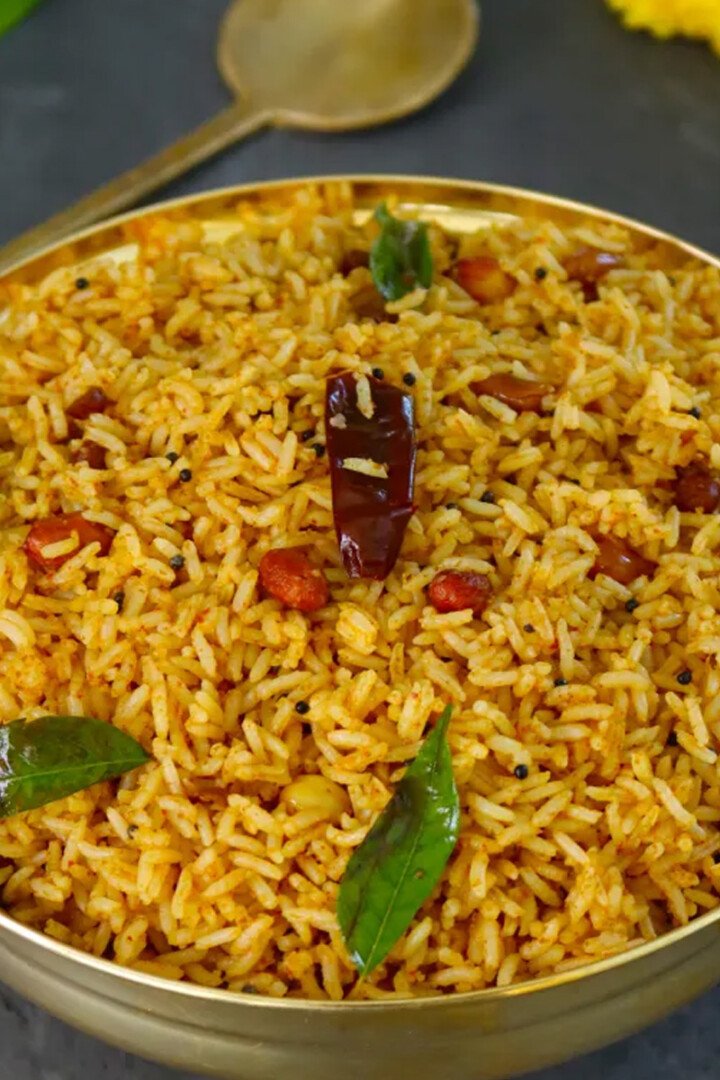
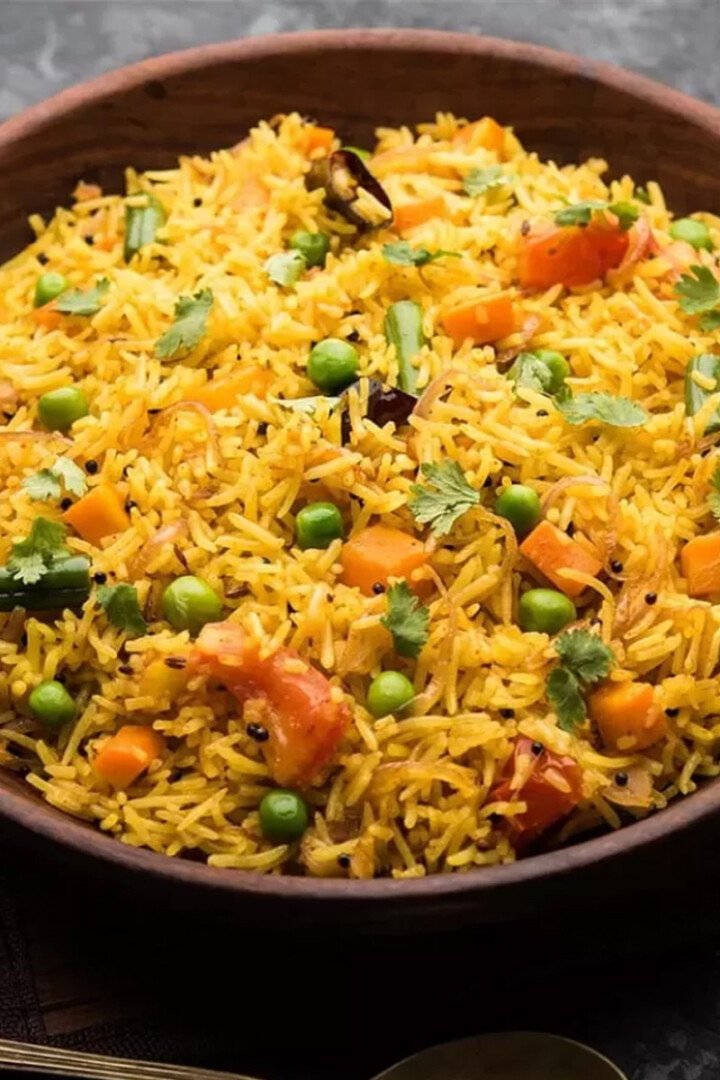
Leave a Reply